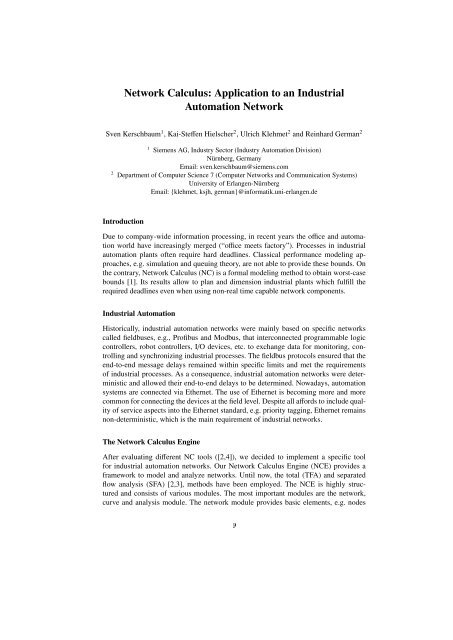MMB & DFT 2012 Workshop Proceedings
MMB & DFT 2012 Workshop Proceedings
MMB & DFT 2012 Workshop Proceedings
You also want an ePaper? Increase the reach of your titles
YUMPU automatically turns print PDFs into web optimized ePapers that Google loves.
Network Calculus: Application to an IndustrialAutomation NetworkSven Kerschbaum 1 , Kai-Steffen Hielscher 2 , Ulrich Klehmet 2 and Reinhard German 21 Siemens AG, Industry Sector (Industry Automation Division)Nürnberg, GermanyEmail: sven.kerschbaum@siemens.com2 Department of Computer Science 7 (Computer Networks and Communication Systems)University of Erlangen-NürnbergEmail: {klehmet, ksjh, german}@informatik.uni-erlangen.deIntroductionDue to company-wide information processing, in recent years the office and automationworld have increasingly merged (“office meets factory”). Processes in industrialautomation plants often require hard deadlines. Classical performance modeling approaches,e.g. simulation and queuing theory, are not able to provide these bounds. Onthe contrary, Network Calculus (NC) is a formal modeling method to obtain worst-casebounds [1]. Its results allow to plan and dimension industrial plants which fulfill therequired deadlines even when using non-real time capable network components.Industrial AutomationHistorically, industrial automation networks were mainly based on specific networkscalled fieldbuses, e.g., Profibus and Modbus, that interconnected programmable logiccontrollers, robot controllers, I/O devices, etc. to exchange data for monitoring, controllingand synchronizing industrial processes. The fieldbus protocols ensured that theend-to-end message delays remained within specific limits and met the requirementsof industrial processes. As a consequence, industrial automation networks were deterministicand allowed their end-to-end delays to be determined. Nowadays, automationsystems are connected via Ethernet. The use of Ethernet is becoming more and morecommon for connecting the devices at the field level. Despite all affords to include qualityof service aspects into the Ethernet standard, e.g. priority tagging, Ethernet remainsnon-deterministic, which is the main requirement of industrial networks.The Network Calculus EngineAfter evaluating different NC tools ([2,4]), we decided to implement a specific toolfor industrial automation networks. Our Network Calculus Engine (NCE) provides aframework to model and analyze networks. Until now, the total (TFA) and separatedflow analysis (SFA) [2,3], methods have been employed. The NCE is highly structuredand consists of various modules. The most important modules are the network,curve and analysis module. The network module provides basic elements, e.g. nodes9


